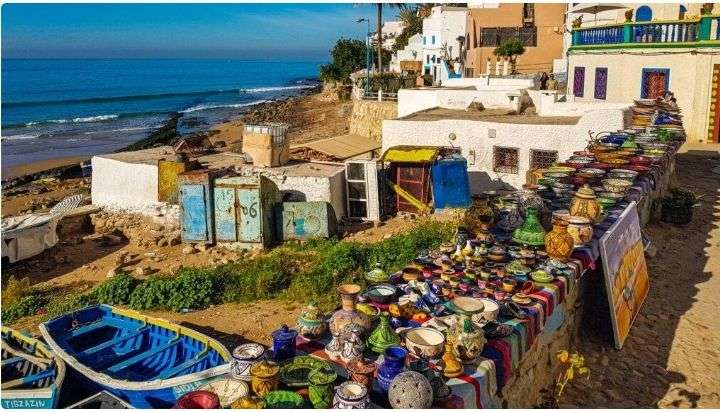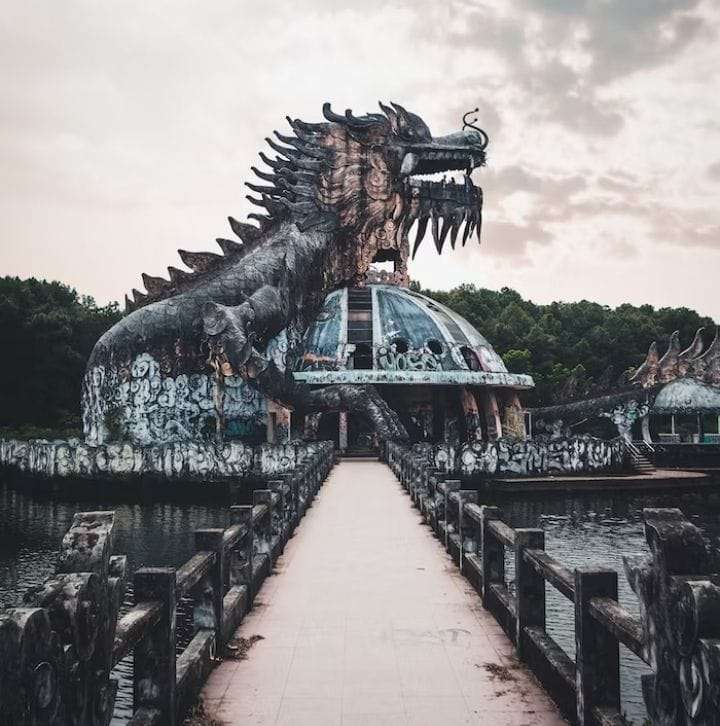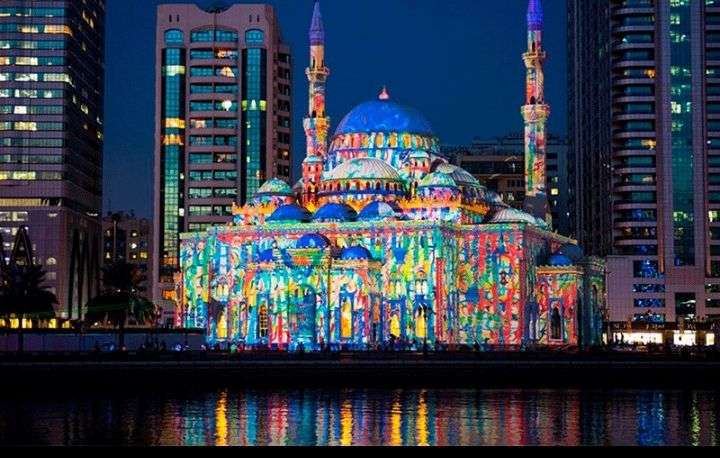Welcome to the land of rising sun, a nation that unfolds like a living canvas, showcasing a dynamic landscape of Japan, where tradition dances harmoniously with innovation. In this captivating realm, the past whispers through ancient temples and tea ceremonies, while the future roars to life amidst the neon-lit streets of modern metropolises.
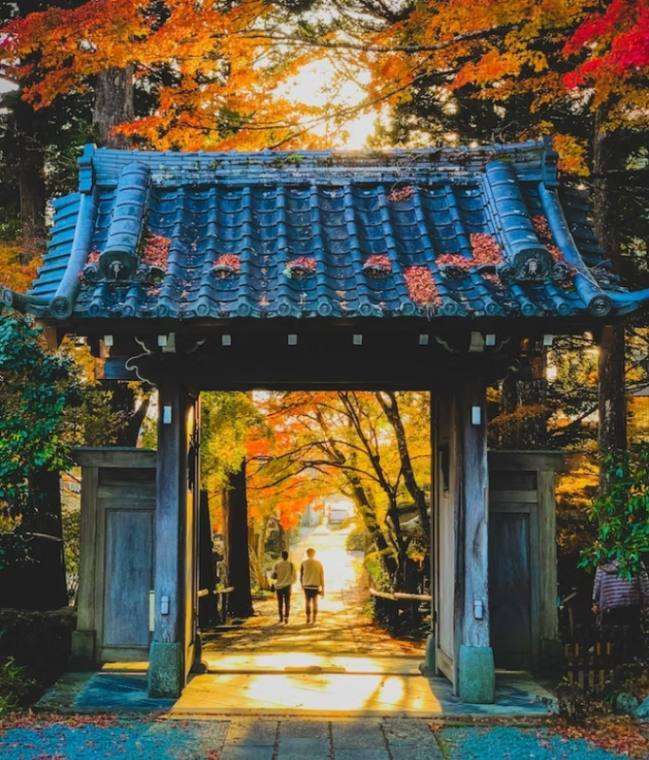
Japan’s dynamic landscape is a shades woven with threads of timeless traditions and cutting-edge technology, offering a journey that transcends static boundaries. Join us as we navigate the ever-changing panorama of Japan, where every step reveals a seamless fusion of history and progress, creating an experience as diverse and dynamic as the country itself.
Contents
basic information
Japan is an island nation located in East Asia and Comparatively less expensive tourist place. It is situated in the Pacific Ocean and consists of four main islands: Honshu, Hokkaido, Kyushu, and Shikoku, along with numerous smaller islands. The geographic coordinates of Japan vary depending on the specific location, as it spans a wide range of latitudes and longitudes.
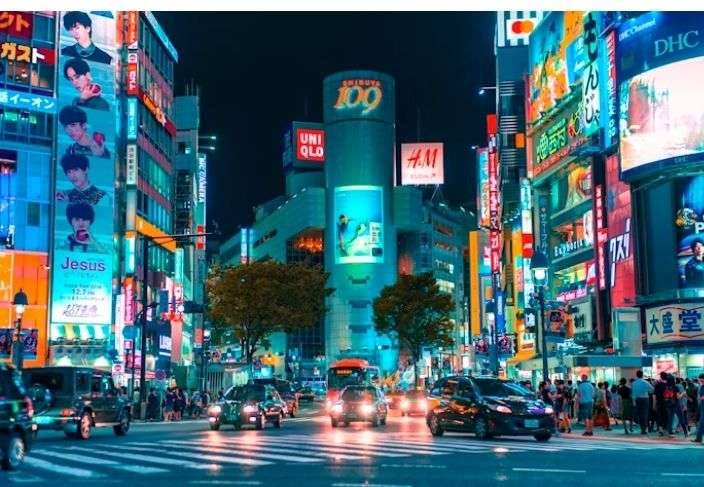
Capital: Tokyo
Population: Approximately 126 million people (as of my last knowledge update in January 2022).
Language: Japanese
Currency: Japanese Yen (JPY)
Government: Constitutional monarchy with a parliamentary government
Religion: Shinto and Buddhism are the two main religions, with a mix of other beliefs.
Climate: Japan experiences a diverse climate, with four distinct seasons: spring, summer, autumn, and winter.
Economy: Japan has a highly developed and technologically advanced economy, with significant contributions from industries such as automotive, electronics, and robotics.
Cultural Heritage: Japan has a rich cultural heritage, including traditional arts like tea ceremony, ikebana (flower arranging), and various forms of traditional theater such as Noh and Kabuki.
Location and map
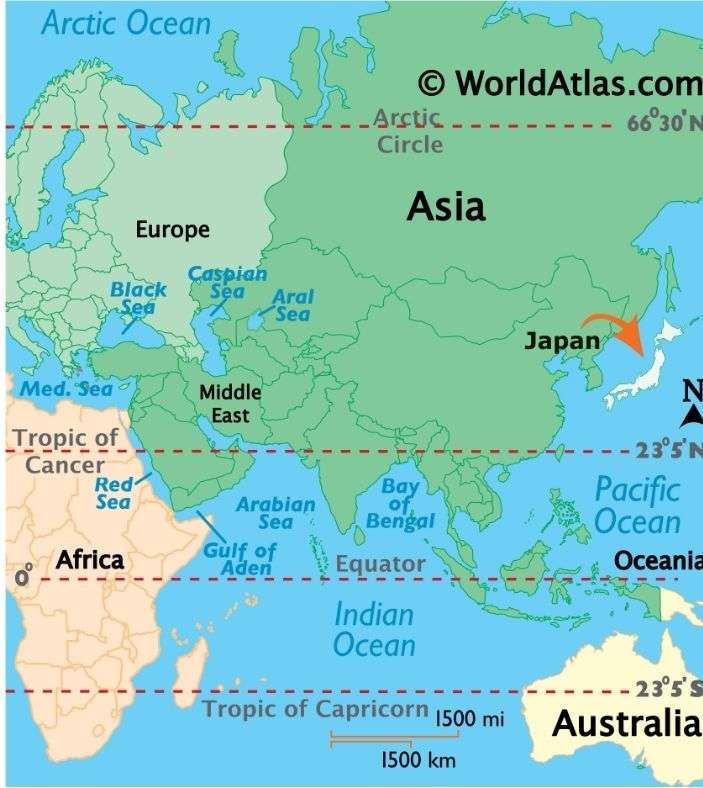
Japan is located in eastern Asia, in the Pacific Ocean. It is a large group of islands that stretch from the Sea of Japan to the Pacific Ocean. Japan shares maritime borders with Russia to the north, China and South Korea to the west, and Taiwan to the south. The island country stretches from the Sea of Okhotsk in the north to the East China Sea in the south. The national capital of Japan is Tokyo, which is located on the eastern coast of the island of Honshu.
Flag of japan
The national flag of Japan is called the Nisshoki or Hinomaru, which means “rising sun” or “circle of the sun.” It consists of a white rectangular field with a large red circular disc in the center. The flag has a height-to-width ratio of 2:3, and the diameter of the red disc is three-fifths of the height of the flag.
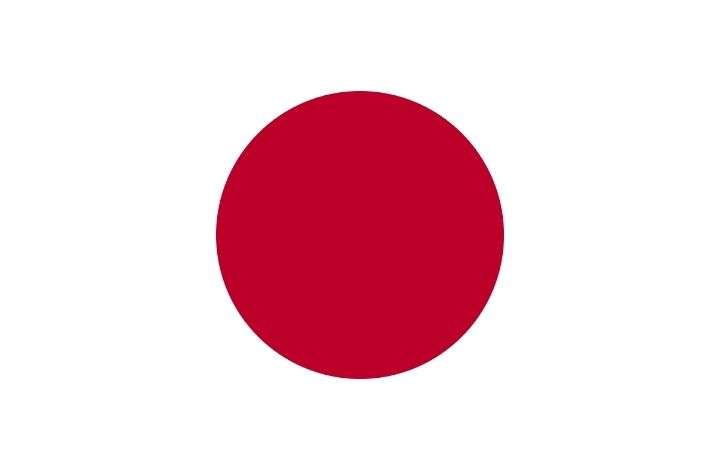
The flag symbolizes the sun, which is an important part of Japanese culture and mythology. The flag was officially adopted on August 5, 1854, and was designated as the national flag in the Act on National Flag and Anthem, which became effective on August 13, 1999. The Rising Sun Flag, which is similar to the national flag but has sixteen red rays emanating from the red disc, is controversial in some countries due to its association with Japanese war crimes during World War.
Natural Features and dynamic landscape of japan
Japan’s dynamic landscapes are a captivating blend of contrasting elements that create a unique tapestry of beauty and diversity. From the serene elegance of cherry blossoms painting the countryside to the bustling energy of Tokyo’s neon-lit streets, the country seamlessly weaves together ancient traditions and cutting-edge modernity. Majestic mountains, including the iconic Mount Fuji, stand in silent contrast to the vibrant coastal areas adorned with sandy beaches and rugged cliffs.
The evergreen forests house a rich tapestry of flora and fauna, while geothermal wonders like hot springs provide moments of tranquil relaxation. As the land of earthquakes, Japan’s dynamic nature extends beyond the visible, reminding us of the constant geological transformations beneath our feet. Whether exploring historic temples in Kyoto or navigating the futuristic cityscape of Osaka, Japan’s dynamic landscapes promise a journey through time, tradition, and innovation.
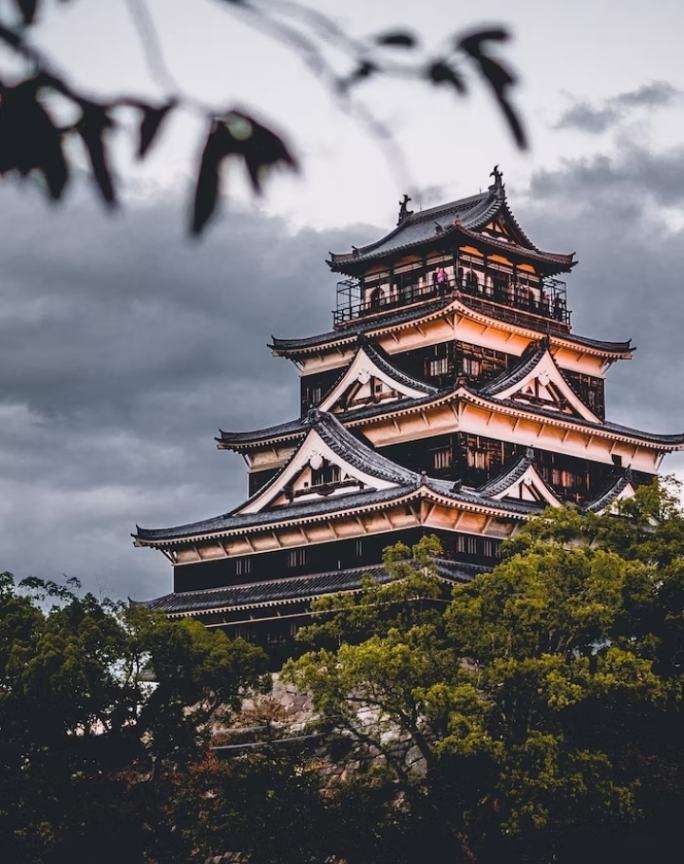
tourist attractions
Mount Fuji:
Mount Fuji is Japan’s highest and most iconic mountain, standing at 3,776 meters. It is an active stratovolcano with a near-perfect conical shape, making it a symbol of Japan. The mountain is a popular climbing destination, with many visitors ascending it during the official climbing season from early July to early September. The surrounding Fuji-Hakone-Izu National Park offers stunning natural beauty, including lakes, hot springs, and scenic views of the mountain.
Imperial Tokyo:
Tokyo, the capital of Japan, is a vibrant metropolis that seamlessly blends modernity with tradition. The city is home to a myriad of attractions, including the historic Senso-ji Temple, the bustling Shibuya Crossing, the serene Meiji Shrine, and the iconic Tokyo Tower. Additionally, visitors can experience the unique juxtaposition of traditional Japanese gardens and contemporary architecture in places like the Hamarikyu Gardens and the Roppongi Hills.
Hiroshima Peace Memorial Park:
This park is a poignant reminder of the devastating impact of the atomic bomb during World War II. It encompasses the Peace Memorial Museum, the A-Bomb Dome, and various monuments dedicated to the memory of the victims. The park serves as a solemn tribute to the lives lost and a symbol of hope for a peaceful future.
Historic Kyoto:
Kyoto, the former imperial capital of Japan, is renowned for its well-preserved traditional architecture and numerous historical landmarks. Visitors can explore the iconic Kinkaku-ji (Golden Pavilion), the Fushimi Inari Taisha Shrine with its famous torii gates, the serene Arashiyama Bamboo Grove, and the beautiful Kiyomizu-dera Temple. The city’s geisha district, Gion, offers a glimpse into Japan’s traditional arts and culture.
The Island Shrine of Itsukushima, Miyajima:
Located in the Seto Inland Sea, Itsukushima Shrine is known for its “floating” torii gate, which appears to be floating on the water during high tide. The island of Miyajima, where the shrine is situated, is also home to friendly wild deer and offers scenic hiking trails with panoramic views.
Temple City:
Historic Nara: Nara is a city steeped in history and home to some of Japan’s oldest and largest temples. The Todai-ji Temple houses a colossal bronze Buddha, and the Kasuga Taisha Shrine is famous for its thousands of hanging lanterns. Nara Park, with its roaming deer, is a picturesque setting for these iconic landmarks.
Osaka Castle:
This historic landmark is a symbol of Osaka and played a major role in the unification of Japan during the 16th century. The castle’s impressive architecture and surrounding gardens attract visitors throughout the year, especially during the cherry blossom season.
Chūbu-Sangaku National Park and the Japanese Alps:
This national park is a mountainous region known for its scenic beauty, including the iconic Japanese Alps. The area offers opportunities for outdoor activities such as hiking, skiing, and hot spring bathing, with picturesque landscapes that have inspired artists and poets for centuries.
Kenrokuen Garden, Kanazawa:
Kenrokuen is considered one of Japan’s most beautiful gardens, featuring a harmonious blend of traditional Japanese garden elements. The garden’s name, which means “garden of six attributes,” refers to the six essential qualities for the perfect garden as defined by Chinese scholars.
Shinjuku Gyoen National Garden:
Located in the heart of Tokyo, Shinjuku Gyoen is a spacious and diverse park that showcases a blend of traditional Japanese, English, and French garden landscapes. The park is a peaceful retreat from the urban bustle, especially during the cherry blossom and autumn foliage seasons.
traveling tips
Certainly! Here are some tips for traveling to Japan:
Transportation:
Invest in a Japan Rail Pass for cost-effective travel on trains.
Get a Suica or Pasmo card for convenient use on public transportation in cities.
Language:
Learn a few basic Japanese phrases; it can enhance your travel experience.
Many signs in tourist areas are also in English, but it’s helpful to have a translation app.
Cash and Cards:always carry some cash with you.
Cultural Etiquette:
Learn and respect Japanese customs, like bowing and removing shoes indoors.
Be mindful of noise levels, as Japan values quiet and tranquility.
Accommodation:consider staying in a ryokan (traditional Japanese inn) for a unique experience.
Local Cuisine:
Try local dishes and street food; Japanese cuisine is diverse and delicious.
Be aware of table manners, such as not tipping at restaurants.
Public Behavior:
Follow public etiquette, like waiting in line and not talking on the phone in public transportation.
Avoid loud conversations in public spaces.
Connectivity:
Rent a portable Wi-Fi device or get a SIM card for easy internet access.
Download offline maps and translation apps for convenience.
Seasonal Considerations:
Check the weather and plan clothing accordingly.
Be aware of peak tourist seasons, especially during cherry blossom and autumn foliage periods.
Safety and Health:
Japan is generally safe, but still, takes standard precautions.
Familiarize yourself with emergency procedures and locations of embassies.
Respect Nature:
Respect the environment, especially in natural settings.
Dispose of trash properly and follow any posted rules.
Shoes and Slippers:
Be prepared to remove your shoes when entering someone’s home or certain traditional accommodations.
Follow the custom of changing into indoor slippers.
conclusion
In conclusion, navigating the dynamic landscape of Japan unveils a tapestry woven with contrasts—where ancient traditions gracefully intertwine with cutting-edge innovation. From the serene beauty of historic temples to the pulsating energy of modern metropolises, Japan offers a journey through time and a glimpse into the future. As you explore the diverse natural features, cultural gems, and vibrant cities, each step reveals a unique blend of history, tradition, and progress. Embark on this enchanting adventure, and let Japan’s dynamic allure captivate your senses, creating memories that resonate through the ages.
Faqs
Q. some popular tourist attractions in Japan?
A. Some popular tourist attractions in Japan include Mount Fuji, Imperial Tokyo, Hiroshima Peace Memorial Park, Historic Kyoto, The Island Shrine of Itsukushima, Miyajima, Temple City: Historic Nara, Osaka Castle, Chūbu-Sangaku National Park and the Japanese Alps, Kenrokuen Garden, Kanazawa, and Shinjuku Gyoen National Garden.
Q. Where is Japan located?
Japan is located in eastern Asia, in the Pacific Ocean. It is a large group of islands that stretch from the Sea of Japan to the Pacific Ocean. Japan have borders with Russia in the north, China and South Korea in the west, and Taiwan in the south.
Q. What is the capital of Japan?
A. The capital of Japan is Tokyo, which is located on the eastern coast of the island of Honshu.
Q. What is the official language of Japan?
Japanese is offevial language in Japan.
Q. What is the currency of Japan?
The currency of Japan is the yen (JPY).
A. What is the population of Japan? As of 2019, the population of Japan is approximately 126.2 million.
Q. What is the climate like in Japan?
A. Japan has a temperate climate with four distinct seasons. The summers are hot and humid, while the winters are cold and snowy in some regions.
Q. What is the time zone in Japan?
A. Japan Standard Time (JST) is 9 hours ahead of Coordinated Universal Time (UTC+9).
Q. What is the transportation system like in Japan?
A. Japan has an extensive and efficient transportation system, including high-speed trains (shinkansen), subways, buses, and taxis. The country also has a well-developed network of airports and ferry services.
Q. What is the cuisine like in Japan?
A. Japanese cuisine is known for its fresh and healthy ingredients, delicate flavors, and beautiful presentation. Sushi is famous dish in Japan.
I’m originally from Manchester (England) but I currently live in New York. I started this travel blog all the way back in 2009 to provide travel advice that wasn’t available in the guidebooks.
Since then I’ve traveled to over 60 countries, a lot of the time, solo. My site is filled with destination guides, things to do, epic itineraries and money-saving travel tips. I hope I can inspire you to see the world!

